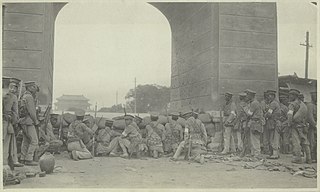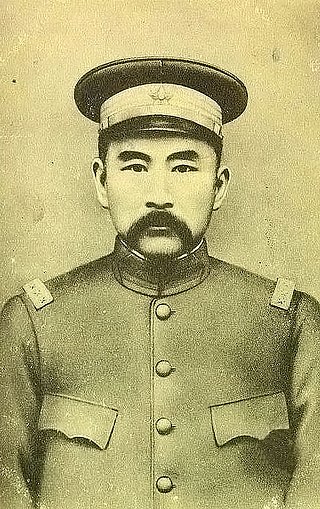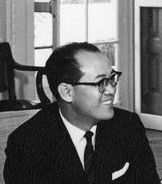| |||||
| Decades: | |||||
|---|---|---|---|---|---|
| See also: | Other events of 1917 History of China • Timeline • Years | ||||
Events in the year 1917 in China .
| |||||
| Decades: | |||||
|---|---|---|---|---|---|
| See also: | Other events of 1917 History of China • Timeline • Years | ||||
Events in the year 1917 in China .
1917 (MCMXVII) was a common year starting on Monday of the Gregorian calendar and a common year starting on Sunday of the Julian calendar, the 1917th year of the Common Era (CE) and Anno Domini (AD) designations, the 917th year of the 2nd millennium, the 17th year of the 20th century, and the 8th year of the 1910s decade. As of the start of 1917, the Gregorian calendar was 13 days ahead of the Julian calendar, which remained in localized use until 1923.

The president of the Republic of China, commonly known as the president of Taiwan, is the head of state of the Republic of China (Taiwan) as well as the commander-in-chief of the Republic of China Armed Forces. The position once had authority of ruling over Mainland China, but its remaining jurisdictions has been limited to Taiwan, Penghu, Kinmen, Matsu, and other smaller islands since the conclusion of the Chinese Civil War.

Li Yuanhong was a Chinese politician during the Qing dynasty and the Republic of China. He was the president of the Republic of China between 1916 and 1917, and between 1922 and 1923.

The Allies, or the Entente Powers, were an international military coalition of countries led by France, the United Kingdom, Russia, the United States, Italy, and Japan against the Central Powers of Germany, Austria-Hungary, the Ottoman Empire, and Bulgaria in World War I (1914–1918).

The Immigration Act of 1917 was a United States Act that aimed to restrict immigration by imposing literacy tests on immigrants, creating new categories of inadmissible persons, and barring immigration from the Asia-Pacific zone. The most sweeping immigration act the United States had passed until that time, it followed the Chinese Exclusion Act of 1882 in marking a turn toward nativism. The 1917 act governed immigration policy until it was amended by the Immigration Act of 1924; both acts were revised by the Immigration and Nationality Act of 1952.

Japan participated in World War I from 1914 to 1918 in an alliance with Entente Powers and played an important role in securing the sea lanes in the West Pacific and Indian Oceans against the Imperial German Navy as a member of the Allies. Politically, the Japanese Empire seized the opportunity to expand its sphere of influence in China, and to gain recognition as a great power in postwar geopolitics.

St. John's University (SJU) was a Christian university in Shanghai. It was founded in 1879 by American missionaries.

The Beiyang government was the internationally recognized government of the Republic of China between 1912 and 1928, based in Beijing. It was dominated by the generals of the Beiyang Army, giving it its name.

The National Protection War, also known as the Anti-Monarchy War, was a civil war that took place in China between 1915 and 1916. Only three years earlier, the last Chinese dynasty, the Qing dynasty, had been overthrown and the Republic of China was established in its place. The cause of the war was the proclamation by Yuan Shikai, the President of the Republic, of himself as the Hongxian Emperor of China.
The Constitutional Protection Movement was a series of movements led by Sun Yat-sen to resist the Beiyang government between 1917 and 1922, in which Sun established another government in Guangzhou as a result. It was known as the Third Revolution by the Kuomintang. The constitution that it intended to protect was the Provisional Constitution of the Republic of China. The first movement lasted from 1917 to 1920; the second from 1921 to 1922. An attempted third movement, begun in 1923, ultimately became the genesis for the Northern Expedition in 1926.

The Manchu Restoration or Dingsi Restoration, also known as Zhang Xun Restoration, or Xuantong Restoration, was an attempt to restore the Chinese monarchy by General Zhang Xun, whose army seized Beijing and briefly reinstalled the last emperor of the Qing dynasty, Puyi, to the throne. The restoration lasted just less than two weeks, from July 1, 1917 to July 12, 1917, and was quickly reversed by Republican troops. Despite the uprising's popular name, almost all putschists were ethnic Han.

Zhang Xun, courtesy name Shaoxuan (少軒), art name Songshoulaoren (松壽老人), nickname Bianshuai, was a Chinese general and Qing loyalist who attempted to restore the abdicated emperor Puyi in the Manchu Restoration of 1917. He also supported Yuan Shikai during his time as president.

Events from the year 2001 in Russia.

Tun Omar Ong Yoke Lin was a Malaysian politician, diplomat and businessman. He was a founding member of the Malaysian Chinese Association, and was a key figure in the country's road to independence. Ong served various positions in the government of Malaya and Malaysia, as a Cabinet minister and ambassador.

Duan Qirui was a Chinese warlord, politician and commander of the Beiyang Army who ruled as the effective dictator of northern China in the late 1910s. He was the Premier of the Republic of China on four occasions between 1913 and 1918, and from 1924 to 1926 he served as acting Chief Executive of the Republic of China in Beijing.

Fan Yuanlian, courtesy name Jingsheng, was a Chinese educator and politician who served three separate terms as minister of Education of the Republic of China, from July 1912 to July 1913 and from July 1915 to November 1917, and briefly from August 1920 to December 1921. He also served as president of Tsinghua University from January 1918 to April 1918 and president of Beijing Normal University between July 1923 and September 1924. He was the founding father of Nankai University.

China participated in World War I from 1917 to 1918 in an alliance with the Entente Powers. Although China never sent troops overseas, 140,000 Chinese labourers served for both British and French forces before the end of the war. While neutral since 1914, Duan Qirui, Premier of the Republic of China, spearheaded Chinese involvement in World War I. Duan wanted to integrate China with Europe and the United States by declaring on the side of the Allies against the Central Powers. On 14 August 1917, China ended its neutrality, declaring war on the German Empire and the Austro-Hungarian Empire.